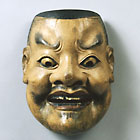Japanese Gallery (Honkan) Room 14
September 19, 2012 (Wed) - October 28, 2012 (Sun)
Noh is a traditional form of Japanese theater originating in sarugaku, which was performed during religious festivals. Many Noh masks are therefore owned by shrines and temples. During the Nanbokucho period (1333-1392), sarugaku performances held at Kasuga shrine and Kohfukuji temple (both in Nara) were performed by four sarugaku schools from the Yamato region: Yusaki-za (Kanze), Tobi-za (Hosho), Sakado-za (Kongo), and Enmani-za (Konparu).
The actor-playwrights Kan'ami and his son Zeami from the Yusaki-za school were patronized by the shogun Ashikaga Yoshimitsu. Successive shoguns also appreciated Noh, which Zeami perfected as a performing art. Noh eventually became the official ceremonial theater of the warrior class, and feudal lords collected many masks from the performances they sponsored.
The Kita school later developed from the Sakado-za school, resulting in the five shitekata schools of Noh that exist today. These schools possessed masks that suited both the repertoire and stagecraft of Noh. From the Nanbokucho to the Muromachi period (1392-1573), new plays were continually created and the variety of masks increased accordingly. Masks from this creative period are especially treasured as honmen. On the other hand, from the following Azuchi-Momoyama period (1573-1603) onward, inherited styles including those of Noh masks were faithfully reproduced. The imitation of earlier masks included the shapes, carvings, scratches, and even flakes of color. It is difficult to date many Noh masks due to their close resemblance to, and rare opportunities for comparison with, honmen masks in the collections of head families.
The Tokyo National Museum has more than 200 Noh masks, including 47 masks and costumes purchased in 1950 that were preserved by the Konparu school. These masks include splendid examples from the earlier creative period. This exhibition introduces the appeal of Noh masks through these masterworks.

